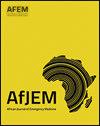Assessing the relationship between armed conflict and infectious disease incidence in Six Sub-Saharan Countries: Implications for Emergency Departments in conflict areas
IF 1.2
4区 医学
Q3 EMERGENCY MEDICINE
引用次数: 0
Abstract
Introduction
This study aimed to update and expand on prior ecological analyses by examining within-country and cross-national correlations between conflict deaths and infectious disease incidence in six neighboring sub-Saharan African countries.
Methods
We analyzed six countries including Uganda, Rwanda, the Democratic Republic of the Congo, Central African Republic, South Sudan, and Burundi using conflict death data from the Uppsala Conflict Data Program and disease incidence data from the World Health Organization databases. Data were analyzed for the maximum period covered in the UCDP for each country, in general from 1990 to the present. Seven diseases were examined: malaria, tuberculosis, human immunodeficiency virus, tetanus, pertussis, measles, and yellow fever. We assembled matrices of regressions between conflict deaths and disease incidence within and across countries. The approach of this study was hypothesis-generating, with the intent to flag associations worthy of further consideration.
Results
Within-country analyses identified strong positive associations in Burundi (e.g., tuberculosis: R² = 0.81, p<0.001; tetanus: R² = 0.59, p<0.001) and Uganda (e.g., tuberculosis: R² = 0.56, p<0.001; malaria: R² = 0.42, p<0.001). Weaker but statistically significant correlations were also observed with measles in Uganda (R² = 0.13, p = 0.04) and Burundi (R² = 0.29, p = 0.001). Cross-nationally, we observed strong correlations between conflict deaths in Burundi and tuberculosis incidence in Uganda (R² = 0.86, p<0.001) and conflict deaths in South Sudan and malaria in the Democratic Republic of the Congo (R² = 0.64, p<0.001).
Conclusion
We confirm prior reports of malaria incidence association with armed conflict while introducing potential new associations involving tetanus and measles. Our hypothesis-generating approach supports further research. Emergency physicians and health systems in conflict-affected and adjacent regions should anticipate shifts in disease burden and consider preparedness strategies.
评估撒哈拉以南六个国家武装冲突与传染病发病率之间的关系:对冲突地区急诊科的影响
本研究旨在通过检查六个邻近的撒哈拉以南非洲国家冲突死亡与传染病发病率之间的国内和跨国相关性,更新和扩展先前的生态分析。方法采用乌普萨拉冲突数据计划中的冲突死亡数据和世界卫生组织数据库中的疾病发病率数据,对乌干达、卢旺达、刚果民主共和国、中非共和国、南苏丹和布隆迪等6个国家进行了分析。对每个国家统一发展方案所涵盖的最长时期的数据进行了分析,总的来说是从1990年到现在。检查了七种疾病:疟疾、肺结核、人类免疫缺陷病毒、破伤风、百日咳、麻疹和黄热病。我们收集了国家内部和国家间冲突死亡与疾病发病率之间的回归矩阵。本研究的方法是假设生成,目的是标记值得进一步考虑的关联。结果国内分析确定了布隆迪(例如,结核病:R²= 0.81,p<0.001;破伤风:R²= 0.59,p<0.001)和乌干达(例如,结核病:R²= 0.56,p<0.001;疟疾:R²= 0.42,p<0.001)的强正相关。乌干达(R²= 0.13,p = 0.04)和布隆迪(R²= 0.29,p = 0.001)与麻疹的相关性也较弱,但有统计学意义。在跨国研究中,我们观察到布隆迪的冲突死亡人数与乌干达的结核病发病率(R²= 0.86,p<0.001)以及南苏丹的冲突死亡人数与刚果民主共和国的疟疾发病率(R²= 0.64,p<0.001)之间存在很强的相关性。结论:我们证实了先前关于疟疾发病率与武装冲突相关的报道,同时引入了破伤风和麻疹的潜在新关联。我们的假设生成方法支持进一步的研究。受冲突影响地区和邻近地区的急诊医生和卫生系统应预测疾病负担的变化,并考虑防范战略。
本文章由计算机程序翻译,如有差异,请以英文原文为准。
求助全文
约1分钟内获得全文
求助全文
来源期刊

African Journal of Emergency Medicine
EMERGENCY MEDICINE-
CiteScore
2.40
自引率
7.70%
发文量
78
审稿时长
85 days
 求助内容:
求助内容: 应助结果提醒方式:
应助结果提醒方式:


